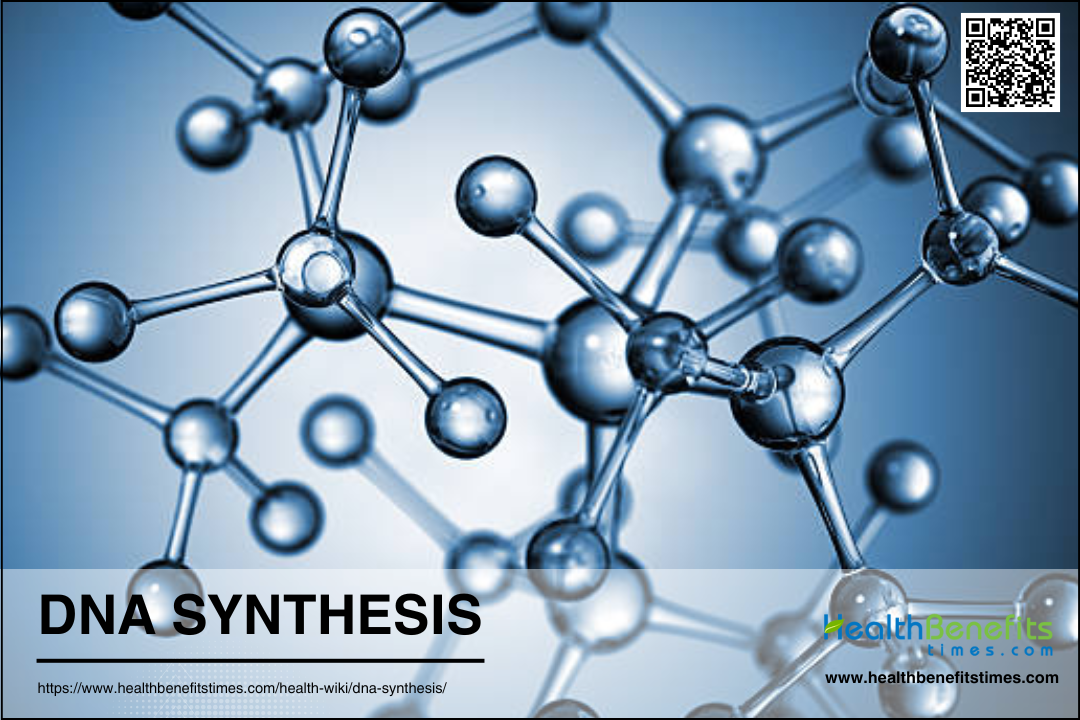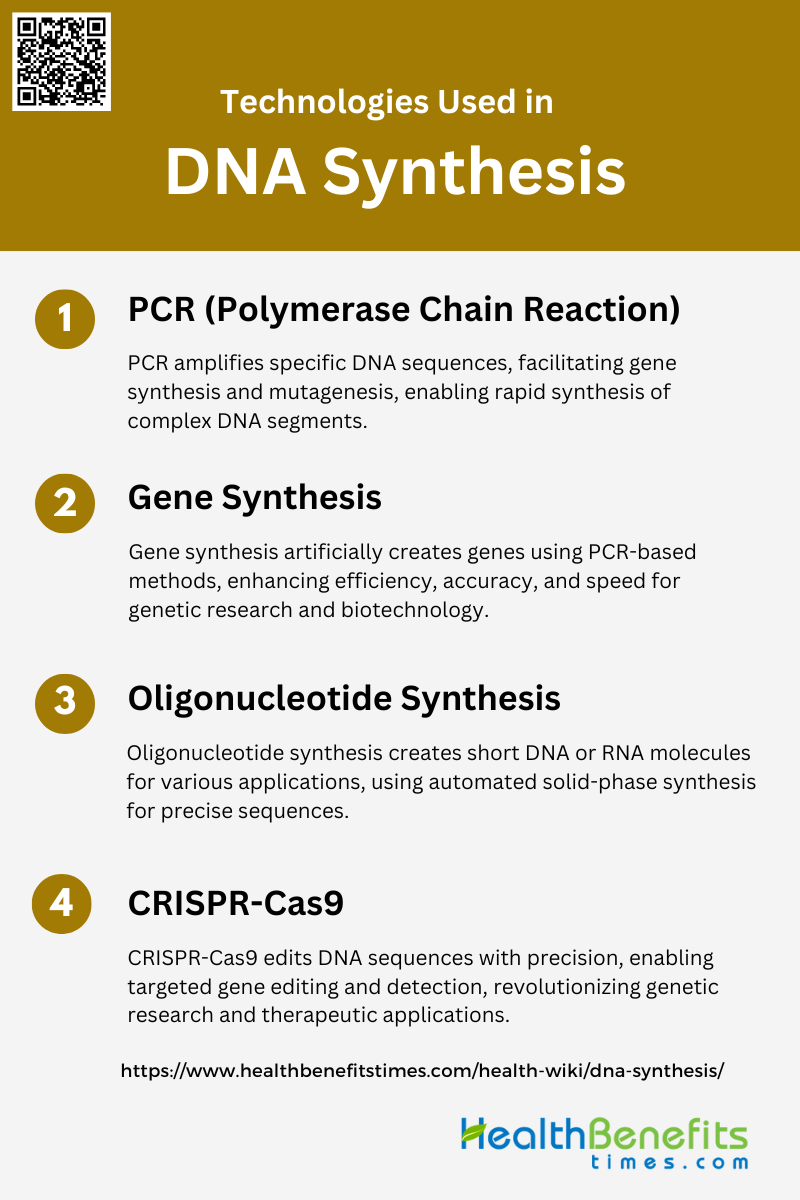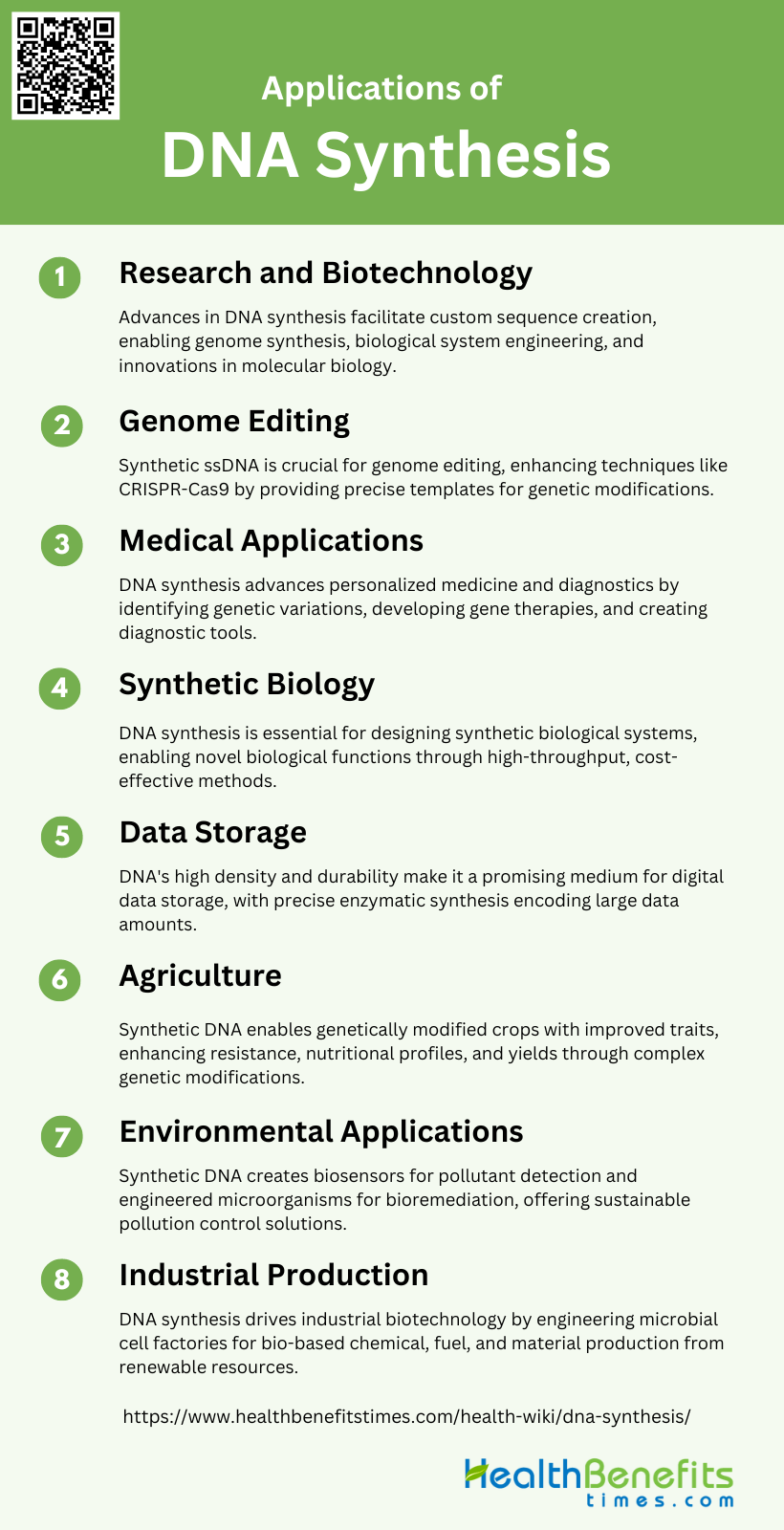DNA synthesis is the process of creating new DNA molecules, either naturally within living organisms or artificially in laboratory settings. In biological systems, DNA synthesis occurs during cell division and is essential for the replication and transmission of genetic information. This process involves the formation of complementary DNA strands using existing DNA as a template, catalyzed by enzymes called DNA polymerases. In biotechnology and research, DNA synthesis refers to the artificial creation of DNA molecules, which can be used for various applications such as genetic engineering, gene therapy, and synthetic biology. Modern DNA synthesis technologies allow researchers to custom-build sequences of oligonucleotides (short DNA strands) using the four nucleobases: Adenine (A), Guanine (G), Cytosine (C), and Thymine (T). These synthetic DNA molecules can be incorporated into organisms to potentially improve disease resistance and lifespan in plants, animals, and humans, making DNA synthesis a crucial tool in advancing scientific understanding and developing new biotechnological applications.
Types of DNA Synthesis
DNA synthesis is a fundamental process that can occur naturally within living organisms or be artificially replicated in laboratory settings. Understanding the different types of DNA synthesis is crucial for various fields, including genetics, biotechnology, and medicine. Below are the primary types of DNA synthesis:
1. Natural DNA Synthesis
Natural DNA synthesis occurs within living organisms and is a fundamental process for cell replication and repair. This process is catalyzed by DNA polymerases, which add nucleotides to a growing DNA strand based on the template strand’s sequence. DNA synthesis in vivo involves several steps, including initiation, elongation, and termination. During replication, the DNA double helix unwinds, and each strand serves as a template for the formation of a new complementary strand. This process ensures the accurate transmission of genetic information from one generation to the next. Natural DNA synthesis is highly regulated and involves various enzymes and proteins to ensure fidelity and efficiency.
2. Synthetic DNA Synthesis
Synthetic DNA synthesis refers to the artificial creation of DNA sequences in a laboratory setting. This can be achieved through various methods, including solid-phase synthesis, enzymatic synthesis, and rolling circle amplification. Solid-phase synthesis, for example, allows for the sequential addition of nucleotides to create oligonucleotides of defined sequences. Enzymatic methods, such as those using T7 RNA polymerase, can produce RNA from synthetic DNA templates. Another approach involves the assembly of smaller DNA fragments into larger sequences using techniques like ligation-independent cloning (LIC). These methods enable the production of custom DNA sequences for research, therapeutic, and industrial applications, offering high precision and scalability.
Technologies Used in DNA Synthesis
Advancements in DNA synthesis have led to the development of various technologies that enable precise and efficient creation of DNA sequences. These technologies are essential for research, medical, and industrial applications. Below are some of the key technologies used in DNA synthesis:
1. PCR (Polymerase Chain Reaction)
Polymerase Chain Reaction (PCR) is a fundamental technology in DNA synthesis that allows for the amplification of specific DNA sequences. Initially described by Mullis, PCR has evolved to include various methodologies that enhance its efficiency and precision. For instance, PCR-mediated gene synthesis facilitates the precise fusion of different DNA fragments, which is particularly useful in gene synthesis and site-directed mutagenesis. Additionally, advanced techniques like the PCR-based two-step DNA synthesis (PTDS) method enable the rapid and high-fidelity synthesis of long DNA segments, making it suitable for complex gene structures. The integration of assembly and amplification steps in a single reaction using high-speed thermocyclers further streamlines the process, allowing for the synthesis of genes in under 20 minutes.
2. Gene Synthesis
Gene synthesis involves the artificial creation of genes in the laboratory, which can be achieved through various PCR-based methods. One such method is the integrated polymerase chain assembly (PCA) and PCR amplification, which allows for the synthesis of genes ranging from a few hundred to several kilobase pairs in length. Another approach involves the use of automated DNA synthesizers to create the entire top and bottom strands of a gene, followed by PCR amplification to construct the target gene. Sequential overlap extension PCR (OE-PCR) is another efficient method for gene synthesis, involving the design of paired complementary oligonucleotides and sequential PCR steps to synthesize full-length genes. These methods collectively enhance the efficiency, accuracy, and speed of gene synthesis, making it a valuable tool in genetic research and biotechnology.
3. Oligonucleotide Synthesis
Oligonucleotide synthesis is the chemical synthesis of short DNA or RNA molecules, which are essential for various applications in molecular biology. These oligonucleotides serve as primers in PCR, building blocks in gene synthesis, and probes in DNA detection assays. The synthesis process typically involves automated solid-phase synthesis, which allows for the rapid and precise creation of oligonucleotides with specific sequences. Advances in oligonucleotide synthesis have enabled the production of long and complex sequences, which are crucial for the assembly of large genes and the study of gene function and expression. The ability to synthesize high-quality oligonucleotides with minimal errors is fundamental to the success of downstream applications in DNA synthesis and genetic engineering.
4. CRISPR-Cas9
CRISPR-Cas9 is a revolutionary genome editing technology that allows for precise and efficient modifications of DNA sequences. Originating from the adaptive immune system of bacteria, CRISPR-Cas9 uses a guide RNA (sgRNA) to direct the Cas9 endonuclease to specific DNA target sites, where it introduces double-strand breaks. This technology has transformed genome engineering by enabling targeted gene editing, regulation, and visualization of genomic loci in a wide array of organisms. CRISPR-Cas9 has also been adapted for DNA detection, combining its high specificity with PCR to create methods like CRISPR/Cas9-typing PCR (ctPCR4.0) for sensitive and specific DNA detection. Additionally, isothermal amplification techniques like CRISDA leverage CRISPR-Cas9 for ultrasensitive DNA detection without the need for thermocycling, making it suitable for point-of-care diagnostics. The versatility and simplicity of CRISPR-Cas9 continue to drive innovations in genetic research and therapeutic applications.
Applications of DNA Synthesis
DNA synthesis has revolutionized numerous fields by enabling the creation of custom DNA sequences for various purposes. These applications span from medical research to industrial biotechnology, offering innovative solutions and advancements. Below are some of the primary applications of DNA synthesis:
1. Research and Biotechnology
Techniques such as phosphoramidite chemistry and enzymatic methods have significantly advanced the synthesis of oligonucleotides, facilitating the study and engineering of biological systems. These advancements have allowed for the synthesis of entire genomes, which is crucial for understanding gene function and regulation. Additionally, the development of high-throughput and cost-effective synthesis methods has made synthetic DNA more accessible, driving innovations in molecular biology and biotechnology.
2. Genome Editing
The synthesis of single-stranded DNA (ssDNA) has become a fundamental tool for genome editing. Methods like PECAN (paired-end cutting assisted by DNAzymes) enable the production of high-purity ssDNA, which is essential for homology-directed repair in genome editing. These synthetic DNA fragments can be designed to target specific genomic loci, allowing precise modifications. The ability to produce custom ssDNA sequences has expanded the capabilities of genome editing technologies, such as CRISPR-Cas9, by providing the necessary templates for introducing specific genetic changes.
3. Medical Applications
Advances in DNA sequencing and synthesis technologies have enabled the identification of genetic variations associated with diseases, paving the way for tailored therapeutic interventions. For instance, synthetic DNA can be used to develop gene therapies that correct genetic defects or to create diagnostic tools that detect disease-related genetic markers. The ability to synthesize DNA sequences rapidly and accurately is crucial for the development of these medical applications.
4. Synthetic Biology
In synthetic biology, DNA synthesis is a cornerstone technology that allows for the design and construction of synthetic biological systems. The chemical synthesis of DNA oligonucleotides and their assembly into larger constructs, such as genes and circuits, enable the creation of novel biological functions. Recent advancements in microchip-based gene synthesis technologies have increased the throughput and decreased the cost of gene synthesis, facilitating the exploration of complex biological hypotheses. These innovations are driving the field of synthetic biology towards new frontiers.
5. Data Storage
Enzymatic DNA synthesis methods, such as those utilizing terminal deoxynucleotidyl transferase (TdT), have been developed to encode digital information into DNA sequences. These methods allow for the precise control of nucleotide incorporation, enabling the storage of large amounts of data in a compact form. The development of robust synthesis and sequencing techniques is essential for the practical implementation of DNA-based data storage systems.
6. Agriculture
Synthetic DNA plays a crucial role in agricultural biotechnology by enabling the development of genetically modified crops with improved traits. The ability to synthesize specific DNA sequences allows for the introduction of genes that confer resistance to pests, diseases, and environmental stresses7. This technology also facilitates the creation of crops with enhanced nutritional profiles and higher yields. Advances in DNA synthesis methods have made it possible to engineer complex genetic modifications, driving innovations in sustainable agriculture.
7. Environmental Applications
Synthetic DNA can be used to create biosensors that detect environmental pollutants or pathogens with high sensitivity and specificity. Additionally, engineered microorganisms with synthetic DNA constructs can be designed to degrade environmental contaminants, offering sustainable solutions for pollution control. The ability to synthesize custom DNA sequences enables the creation of tailored biological systems for various environmental applications.
8. Industrial Production
In industrial biotechnology, DNA synthesis enables the production of bio-based chemicals, fuels, and materials. Synthetic biology approaches, powered by DNA synthesis, allow for the engineering of microbial cell factories that produce valuable compounds from renewable resources. The ability to design and construct synthetic metabolic pathways in microorganisms has led to the development of efficient bioprocesses for industrial production. Advances in DNA synthesis technologies are driving the industrial application of synthetic biology, leading to more sustainable and cost-effective production methods.
Errors in DNA Synthesis and Their Consequences
Types of DNA Synthesis Errors
DNA synthesis errors can occur in various forms, including the mis-insertion of ribonucleotides instead of deoxyribonucleotides, which can lead to genome instability if not corrected. Errors also arise during the repair of double-strand breaks (DSBs) through homologous recombination, which is highly inaccurate and a significant source of mutations. Additionally, the use of error-prone translesion DNA polymerases during DNA repair can introduce further inaccuracies.
Consequences of Errors
The consequences of DNA synthesis errors are profound, leading to genomic instability, cell death, and oncogenic transformations due to chromosomal translocations. Unrepaired ribonucleotides in DNA can cause chromosomal aberrations and are associated with severe autoimmune syndromes, neuropathology, and cancer. Errors in DNA polymerase proofreading and mismatch repair mechanisms are linked to increased cancer incidence and high mutation loads in tumors.
Repair Mechanisms
Cells employ several repair mechanisms to correct DNA synthesis errors. Ribonucleotide excision repair (RER) removes mis-incorporated ribonucleotides to maintain genome stability. Homologous recombination and classical nonhomologous end joining (C-NHEJ) are primary pathways for repairing DSBs, while alternative end joining (alt-EJ) and single-strand annealing (SSA) contribute to error-prone repairs. Base excision repair, nucleotide excision repair, and mismatch repair pathways correct errors made during DNA synthesis and remove DNA damage.
Real-World Examples
Real-world examples of the consequences of DNA synthesis errors include the development of cancer due to defective mismatch and excision repair processes6. The high mutation load in tumors with defective DNA polymerase proofreading highlights the role of these errors in cancer progression. Additionally, the HEDGES error-correcting code for DNA storage demonstrates the practical application of understanding and correcting DNA synthesis errors to achieve error-free data storage.




